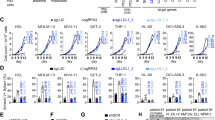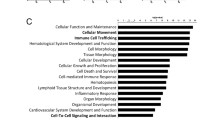Abstract
Purpose
Cell fate determinants Scrib and Llgl1 influence self-renewal capacity of hematopoietic stem cells (HSCs). Scrib-deficient HSCs are functionally impaired and lack sufficient repopulation capacity during serial transplantation and stress. In contrast, loss of Llgl1 leads to increased HSC fitness, gain of self-renewal capacity and expansion of the stem cell pool. Here, we sought to assess for shared and unique molecular functions of Llgl1 and Scrib by analyzing their interactome in hematopoietic cells.
Methods
Interactome analysis was performed by affinity purification followed by mass spectrometry. Motility, migration and adhesion were assessed on primary murine HSCs, which were isolated by FACS sorting following conditional deletion of Scrib or Llgl1, respectively. Imaging of Scrib-deficient HSCs was performed by intravital 2-photon microscopy.
Results
Comparison of Scrib and Llgl1 interactome analyses revealed involvement in common and unique cellular functions. Migration and adhesion were among the cellular functions connected to Scrib but not to Llgl1. Functional validation of these findings confirmed alterations in cell adhesion and migration of Scrib-deficient HSCs in vitro and in vivo. In contrast, genetic inactivation of Llgl1 did not affect adhesion or migratory capacity of hematopoietic stem cells.
Conclusion
Our data provide first evidence for an evolutionarily conserved role of the cell fate determinant Scrib in HSC adhesion and migration in vitro and in vivo, a unique function that is not shared with its putative complex partner Llgl1.






Similar content being viewed by others
References
Althoff MJ et al (2017) Scribble controls HSC self-renewal through polarity-dependent activation of the hippo signaling pathway. Blood 130:710
Arquier N, Perrin L, Manfruelli P, Semeriva M (2001) The Drosophila tumor suppressor gene lethal(2)giant larvae is required for the emission of the Decapentaplegic signal. Development 128:2209–2220
Bilder D, Li M, Perrimon N (2000) Cooperative regulation of cell polarity and growth by Drosophila tumor suppressors. Science 289:113–116
Boulais PE, Frenette PS (2015) Making sense of hematopoietic stem cell niches. Blood 125:2621–2629. https://doi.org/10.1182/blood-2014-09-570192
Dow LE et al (2007) The tumour-suppressor Scribble dictates cell polarity during directed epithelial migration: regulation of Rho GTPase recruitment to the leading edge. Oncogene 26:2272–2282. https://doi.org/10.1038/sj.onc.1210016
Essers MA, Offner S, Blanco-Bose WE, Waibler Z, Kalinke U, Duchosal MA, Trumpp A (2009) IFNalpha activates dormant haematopoietic stem cells in vivo. Nature 458:904–908. https://doi.org/10.1038/nature07815
Florian MC et al (2012) Cdc42 activity regulates hematopoietic stem cell aging and rejuvenation. Cell Stem Cell 10:520–530. https://doi.org/10.1016/j.stem.2012.04.007
Florian MC et al (2013) A canonical to non-canonical Wnt signalling switch in haematopoietic stem-cell ageing. Nature 503:392–396. https://doi.org/10.1038/nature12631
Giebel B, Bruns I (2008) Self-renewal versus differentiation in hematopoietic stem and progenitor cells: a focus on asymmetric cell divisions. Curr Stem Cell Res Ther 3:9–16
Hartleben B et al (2012) Role of the polarity protein Scribble for podocyte differentiation and maintenance. PLoS One 7:e36705. https://doi.org/10.1371/journal.pone.0036705
Hawkins ED et al (2013) Regulation of asymmetric cell division and polarity by Scribble is not required for humoral immunity. Nat Commun 4:1801. https://doi.org/10.1038/ncomms2796
Hawkins ED et al (2014) Lethal giant larvae 1 tumour suppressor activity is not conserved in models of mammalian T and B cell leukaemia. PLoS One 9:e87376. https://doi.org/10.1371/journal.pone.0087376
Hawkins ED, Oliaro J, Ramsbottom KM, Newbold A, Humbert PO, Johnstone RW, Russell SM (2016) Scribble acts as an oncogene in Emu-myc-driven lymphoma. Oncogene 35:1193–1197. https://doi.org/10.1038/onc.2015.167
Heidel FH et al (2012) Genetic and pharmacologic inhibition of beta-catenin targets imatinib-resistant leukemia stem cells in CML. Cell Stem Cell 10:412–424. https://doi.org/10.1016/j.stem.2012.02.017
Heidel FH et al (2013) The cell fate determinant Llgl1 influences HSC fitness and prognosis in AML. J Exp Med 210:15–22. https://doi.org/10.1084/jem.20120596
Heidel FH, Arreba-Tutusaus P, Armstrong SA, Fischer T (2015) Evolutionarily conserved signaling pathways: acting in the shadows of acute myelogenous leukemia’s genetic diversity. Clin Cancer Res 21:240–248. https://doi.org/10.1158/1078-0432.CCR-14-1436
Humbert PO, Dow LE, Russell SM (2006) The Scribble and par complexes in polarity and migration: friends or foes? Trends Cell Biol 16:622–630. https://doi.org/10.1016/j.tcb.2006.10.005
Humbert PO, Grzeschik NA, Brumby AM, Galea R, Elsum I, Richardson HE (2008) Control of tumourigenesis by the Scribble/Dlg/Lgl polarity module. Oncogene 27:6888–6907. https://doi.org/10.1038/onc.2008.341
Klezovitch O, Fernandez TE, Tapscott SJ, Vasioukhin V (2004) Loss of cell polarity causes severe brain dysplasia in Lgl1 knockout mice. Genes Dev 18:559–571. https://doi.org/10.1101/gad.1178004
Knoblich JA (2010) Asymmetric cell division: recent developments and their implications for tumour biology. Nat Rev Mol Cell Biol 11:849–860. https://doi.org/10.1038/nrm3010
Lhoumeau AC et al (2016) Ptk7-deficient mice have decreased hematopoietic stem cell pools as a result of deregulated proliferation and migration. J Immunol 196:4367–4377. https://doi.org/10.4049/jimmunol.1500680
Lo Celso C et al (2009) Live-animal tracking of individual haematopoietic stem/progenitor cells in their niche. Nature 457:92–96. https://doi.org/10.1038/nature07434
Ludford-Menting MJ et al (2005) A network of PDZ-containing proteins regulates T cell polarity and morphology during migration and immunological synapse formation. Immunity 22:737–748. https://doi.org/10.1016/j.immuni.2005.04.009
Manfruelli P, Arquier N, Hanratty WP, Semeriva M (1996) The tumor suppressor gene, lethal(2)giant larvae (1(2)g1), is required for cell shape change of epithelial cells during Drosophila development. Development 122:2283–2294
Mohr J et al (2018) The cell fate determinant Scribble is required for maintenance of hematopoietic stem cell function. Leukemia 32:1211–1221. https://doi.org/10.1038/s41375-018-0025-0
Murdoch JN et al (2003) Disruption of scribble (Scrb1) causes severe neural tube defects in the circletail mouse. Hum Mol Genet 12:87–98
Pietras EM, Lakshminarasimhan R, Techner JM, Fong S, Flach J, Binnewies M, Passegue E (2014) Re-entry into quiescence protects hematopoietic stem cells from the killing effect of chronic exposure to type I interferons. J Exp Med 211:245–262. https://doi.org/10.1084/jem.20131043
Pike KA, Kulkarni S, Pawson T (2011) Immature T-cell clustering and efficient differentiation require the polarity protein Scribble. Proc Natl Acad Sci USA 108:1116–1121. https://doi.org/10.1073/pnas.1018224108
Prashad SL et al (2015) GPI-80 defines self-renewal ability in hematopoietic stem cells during human development. Cell Stem Cell 16:80–87. https://doi.org/10.1016/j.stem.2014.10.020
Sengupta A et al (2011) Atypical protein kinase C (aPKCzeta and aPKClambda) is dispensable for mammalian hematopoietic stem cell activity and blood formation. Proc Natl Acad Sci USA 108:9957–9962. https://doi.org/10.1073/pnas.1103132108
Szklarczyk D et al (2017) The STRING database in 2017: quality-controlled protein-protein association networks made broadly accessible. Nucleic Acids Res 45:D362–D368. https://doi.org/10.1093/nar/gkw937
Walter D et al (2015) Exit from dormancy provokes DNA-damage-induced attrition in haematopoietic stem cells. Nature 520:549–552. https://doi.org/10.1038/nature14131
Yang L, Wang L, Geiger H, Cancelas JA, Mo J, Zheng Y (2007) Rho GTPase Cdc42 coordinates hematopoietic stem cell quiescence and niche interaction in the bone marrow. Proc Natl Acad Sci USA 104:5091–5096. https://doi.org/10.1073/pnas.0610819104
Acknowledgements
We thank Ms. St. Frey and Mr. V.R. Thangapandi for technical assistance, A. Fenske DVM (Magdeburg) for his support with animal care and Dr. R. Hartig (Magdeburg) and Katrin Schubert (Core Facility Flow Cytometry, FLI, Jena) for their support with cell sorting. Moreover, we thank the Center for Molecular Medicine of the Austrian Academy of Sciences (CeMM, Vienna) for providing the pCeMM-NTAP vector.
Funding
This work was supported by a grant of the German Research Council (DFG HE6233/2-1) and in part by a grant of the Else-Kröner-Fresenius Stiftung (2012-A152) to F.H.H. Moreover, the project was supported by the Thuringian state program ProExzellenz (RegenerAging—FSU-I-03/14) of the Thuringian Ministry for Research (TMWWDG) to F.H.H. TBH was supported by the DFG (CRC1140, CRC 992), by the BMBF (01GM1518C), by the European Research Council-ERC Grant 616891 and by the H2020-IMI2 consortium BEAt-DKD.
Author information
Authors and Affiliations
Contributions
BPD, JM, CK, TMS, CH, SG, CZ, FP and TK performed experiments and analyzed data. MN, BH, TH and GW provided material. TH, TK, DSK and FHH analyzed data and provided material. TK and BPD contributed to the writing of the manuscript. FHH supervised the research and wrote the paper.
Corresponding author
Ethics declarations
Conflict of interest
None.
Ethical approval
This study does not involve any human samples or material. All animal experiments were conducted after approval by the Landesverwaltungsamt Saxony-Anhalt.
Rights and permissions
About this article
Cite this article
Dash, B.P., Schnöder, T.M., Kathner, C. et al. Diverging impact of cell fate determinants Scrib and Llgl1 on adhesion and migration of hematopoietic stem cells. J Cancer Res Clin Oncol 144, 1933–1944 (2018). https://doi.org/10.1007/s00432-018-2724-3
Received:
Accepted:
Published:
Issue Date:
DOI: https://doi.org/10.1007/s00432-018-2724-3




